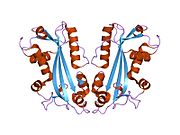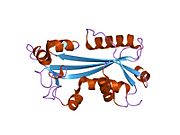Biology:ITPA
 Generic protein structure example |
Inosine triphosphate pyrophosphatase is an enzyme that in humans is encoded by the ITPA gene,[1][2] by the rdgB gene in bacteria E.coli[3] and the HAM1 gene in yeast S. cerevisiae;[4] the protein is also encoded by some RNA viruses of the Potyviridae family.[5] Two transcript variants encoding two different isoforms have been found for this gene. Also, at least two other transcript variants have been identified which are probably regulatory rather than protein-coding.[citation needed]
Function
The protein encoded by this gene hydrolyzes inosine triphosphate and deoxyinosine triphosphate to the monophosphate nucleotide and diphosphate.[2] The enzyme possesses a multiple substrate-specificity and acts on other nucleotides including xanthosine triphosphate and deoxyxanthosine triphosphate.[4] The encoded protein, which is a member of the HAM1 NTPase protein family, is found in the cytoplasm and acts as a homodimer.
Clinical significance
Defects in the encoded protein can result in inosine triphosphate pyrophosphorylase deficiency.[2] The enzyme ITPase dephosphorylates ribavirin triphosphate in vitro to ribavirin monophosphate, and ITPase reduced enzymatic activity present in 30 % of humans potentiates mutagenesis in hepatitis C virus.[6] Gene variants predicting reduced predicted ITPase activity have been associated with decreased risk of ribavirin-induced anemia, increased risk of thrombocytopenia, lower ribavirin concentrations, as well as a ribavirin-like reduced relapse risk following interferon-based therapy for hepatitis C virus (HCV) genotype 2 or 3 infection. [7]
Reading
- "Human inosine triphosphatase: catalytic properties and population studies". Clin. Chim. Acta 97 (2–3): 143–53. 1979. doi:10.1016/0009-8981(79)90410-8. PMID 487601.
- Fraser JH; Meyers H; Henderson JF et al. (1976). "Individual variation in inosine triphosphate accumulation in human erythrocytes". Clin. Biochem. 8 (6): 353–64. doi:10.1016/S0009-9120(75)93685-1. PMID 1204209.
- Clawson GA; Song YL; Schwartz AM et al. (1992). "Interaction of human immunodeficiency virus type I Rev protein with nuclear scaffold nucleoside triphosphatase activity". Cell Growth Differ. 2 (11): 575–82. PMID 1667585.
- Deloukas P; Matthews LH; Ashurst J et al. (2002). "The DNA sequence and comparative analysis of human chromosome 20". Nature 414 (6866): 865–71. doi:10.1038/414865a. PMID 11780052. Bibcode: 2001Natur.414..865D.
- Sumi S; Marinaki AM; Arenas M et al. (2002). "Genetic basis of inosine triphosphate pyrophosphohydrolase deficiency". Hum. Genet. 111 (4–5): 360–7. doi:10.1007/s00439-002-0798-z. PMID 12384777.
- "DNA polymorphisms in ITPA including basis of inosine triphosphatase deficiency". J. Hum. Genet. 47 (11): 620–2. 2003. doi:10.1007/s100380200095. PMID 12436200.
- Strausberg RL; Feingold EA; Grouse LH et al. (2003). "Generation and initial analysis of more than 15,000 full-length human and mouse cDNA sequences". Proc. Natl. Acad. Sci. U.S.A. 99 (26): 16899–903. doi:10.1073/pnas.242603899. PMID 12477932. Bibcode: 2002PNAS...9916899M.
- Gerhard DS; Wagner L; Feingold EA et al. (2004). "The Status, Quality, and Expansion of the NIH Full-Length cDNA Project: The Mammalian Gene Collection (MGC)". Genome Res. 14 (10B): 2121–7. doi:10.1101/gr.2596504. PMID 15489334.
- Marinaki AM; Duley JA; Arenas M et al. (2005). "Mutation in the ITPA gene predicts intolerance to azathioprine". Nucleosides Nucleotides Nucleic Acids 23 (8–9): 1393–7. doi:10.1081/NCN-200027639. PMID 15571265.
- Marinaki AM; Sumi S; Arenas M et al. (2005). "Allele frequency of inosine triphosphate pyrophosphatase gene polymorphisms in a Japanese population". Nucleosides Nucleotides Nucleic Acids 23 (8–9): 1399–401. doi:10.1081/NCN-200027641. PMID 15571266.
- Maeda T; Sumi S; Ueta A et al. (2005). "Genetic basis of inosine triphosphate pyrophosphohydrolase deficiency in the Japanese population". Mol. Genet. Metab. 85 (4): 271–9. doi:10.1016/j.ymgme.2005.03.011. PMID 15946879.
- "Pharmacogenetic association with adverse drug reactions to azathioprine immunosuppressive therapy following liver transplantation". Liver Transpl. 11 (7): 826–33. 2005. doi:10.1002/lt.20377. PMID 15973722.
- Porta J; Kolar C; Kozmin SG et al. (2006). "Structure of the orthorhombic form of human inosine triphosphate pyrophosphatase". Acta Crystallographica Section F 62 (Pt 11): 1076–81. doi:10.1107/S1744309106041790. PMID 17077483.
- Arenas M; Duley J; Sumi S et al. (2007). "The ITPA c.94C>A and g.IVS2+21A>C sequence variants contribute to missplicing of the ITPA gene". Biochim. Biophys. Acta 1772 (1): 96–102. doi:10.1016/j.bbadis.2006.10.006. PMID 17113761.
- Stenmark P; Kursula P; Flodin S et al. (2007). "Crystal structure of human inosine triphosphatase. Substrate binding and implication of the inosine triphosphatase deficiency mutation P32T". J. Biol. Chem. 282 (5): 3182–7. doi:10.1074/jbc.M609838200. PMID 17138556.
- Atanasova S; Shipkova M; Svinarov D et al. (2007). "Analysis of ITPA phenotype-genotype correlation in the Bulgarian population revealed a novel gene variant in exon 6". Therapeutic Drug Monitoring 29 (1): 6–10. doi:10.1097/FTD.0b013e3180308554. PMID 17304144.
References
- ↑ "Cloning, expression, and characterization of a human inosine triphosphate pyrophosphatase encoded by the itpa gene". J Biol Chem 276 (22): 18695–701. May 2001. doi:10.1074/jbc.M011084200. PMID 11278832.
- ↑ 2.0 2.1 2.2 "Entrez Gene: ITPA inosine triphosphatase (nucleoside triphosphate pyrophosphatase)". https://www.ncbi.nlm.nih.gov/sites/entrez?Db=gene&Cmd=ShowDetailView&TermToSearch=3704.
- ↑ "Substrate specificity of RdgB protein, a deoxyribonucleoside triphosphate pyrophosphohydrolase". J Biol Chem 282 (8): 3531–8. 2007. doi:10.1074/jbc.M608708200. PMID 17090528.
- ↑ 4.0 4.1 "Characterisation of multiple substrate-specific (d)ITP/(d)XTPase and modelling of deaminated purine nucleotide metabolism". BMB Reports 45 (4): 259–64. 2012. doi:10.5483/BMBRep.2012.45.4.259. PMID 22531138.
- ↑ Pasin, Fabio; Daròs, José-Antonio; Tzanetakis, Ioannis E (2022). "Proteome expansion in the Potyviridae evolutionary radiation" (in en). FEMS Microbiology Reviews 46 (4): fuac011. doi:10.1093/femsre/fuac011. ISSN 1574-6976. PMID 35195244.
- ↑ "Inosine Triphosphate Pyrophosphatase Dephosphorylates Ribavirin Triphosphate and Reduced Enzymatic Activity Potentiates Mutagenesis in Hepatitis C Virus.". Journal of Virology 92 (19): 01087–18. October 2018. doi:10.1002/hep.27009. PMID 30045981.
- ↑ "Variants of the inosine triphosphate pyrophosphatase gene are associated with reduced relapse risk following treatment for HCV genotype 2/3". Hepatology 59 (6): 2131–2139. June 2014. doi:10.1002/hep.27009. PMID 24519039.
 |




